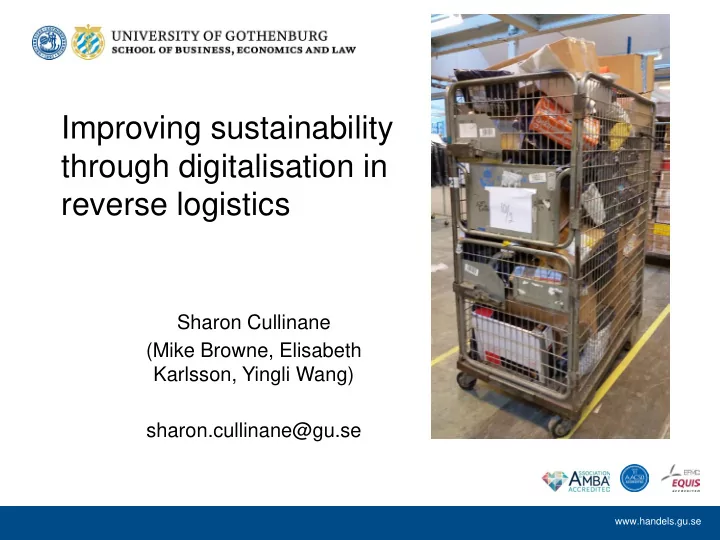

Improving sustainability through digitalisation in reverse logistics Sharon Cullinane (Mike Browne, Elisabeth Karlsson, Yingli Wang) sharon.cullinane@gu.se www.handels.gu.se
Purpose •How can digitalisation help reduce the return rates of clothing bought online? •Currently EU average return rate for clothing is 22% but in high fashion in Germany it can reach 70%!! •This means high costs to retailers and high environmental costs to society www.handels.gu.se
Methodology •Literature review and subsequent primary data collection. •Case studies of the reverse logistics operations of 5 major clothing retailers and 2 major logistics companies in Sweden, carried out in Spring 2017. •Interviews and observations lasting between 3 and 7 hours at each company. www.handels.gu.se
Limitations The research is based on a limited sample of clothing retailers in Sweden, so the findings cannot be generalised to all retailers. However, the research provides some interesting insights which can be followed up in future research. www.handels.gu.se
E-tailing •Clothing is the biggest single sector of e-tailing in most European countries and is growing fast •40% of global shoppers prefer to purchase clothing and footwear online, while 51% prefer in store. •28% of global shoppers purchasing most or all of their clothing and footwear online in the last 12 months (PWC, 2017) www.handels.gu.se
Returns •Average return rate for clothing is 22% but this varies between customer type, clothing type and country. •Approximately 35% of these returns are made cross-border •So, literally billions of items of clothing are being returned to retailers every year. www.handels.gu.se
Reasons for customer returns • Damaged/faulty items • The wrong items being received • The items not looking like they do on the website/not matching expectations • The items not fitting • The customer just changing their mind • Customers buying multiple items and sending some back • Fraudulent reasons • Items never picked up • Returns are free/cheap www.handels.gu.se
Returns by country and brand Brand B (high Brand A (low fashion) fashion) % returns % returns (on an Items (on an Items Country item returned item returned basis) basis) Finland 24.5 126,000 45 51,700 Sweden 15.6 248,000 31.6 176,000 Denmark 13.9 44,000 25.7 10,000 Norway 14.2 74,000 25.3 7,500 Source: case study company with 200 employees www.handels.gu.se
How can digitalisation help? Two main ways: 1. By reducing the number/rate of returns to start with and 2. By making the reverse logistics process more efficient. www.handels.gu.se
1. Reducing the number/rate of returns to start with. (i) Digital changing rooms Digitalisation can reduce the gap between what the customer perceives on the website and the product in reality through virtual changing rooms and other augmented reality apps in which customers can input their measurements and other key body descriptors. www.handels.gu.se
(ii) Social Media • By communicating with customers via social media, products can be described more personally and realistically. • Retailers can monitor the perception of their products. If a product is continuously being described as being wrongly sized or badly made, the image or description can be changed. • If an item has a great many ‘dislikes’, it gives the company the opportunity to determine why. www.handels.gu.se
2. Improving the efficiency of reverse logistics (i) Apps • to improve the quality of information provided to customers so that returns can be reduced. • Parcel tracking apps can provide the customer with real- time pick-up information - reducing the number of failed pick-ups. • Apps linked to smart devices enable parcel carriers to access locations at people’s homes using PIN codes to enable them to pick up returns parcels. However maybe the easier the returns process, the more the returns! www.handels.gu.se
(ii) Electronic data interchange (EDI) • Provides end-to-end visibility of the return enabling collaboration and integration of chain partners. • A combination of barcodes and EDI can enable swifter turnarounds and improved lead time. Better omni-channel integration. • EDI could change C2B into C2C??? • Improves parcel carriers routing and scheduling . www.handels.gu.se
(iii) Radio Frequency Identification (RFID) • Speeds up tracking process enabling shorter lead times for re-sale of returned products and less waste. • Again, segments of the returns process could be eliminated by using RFID www.handels.gu.se
(iv) Customer Profiling •differential charges for returns. Customers who return a lot but don’t buy much could be charged a higher price than those who return little or who return a lot but also buy a lot. •Could also be used to track customers who continuously try to make fraudulent returns www.handels.gu.se
(v) Packaging Digitalise the return label and ‘reason for return’ form – saving paper www.handels.gu.se
Concluding Remarks • Returns posed a big problem for all of our case study companies. • Most agreed that it was a problem that was going to get worse before it got better. • Determinimg which form of digitalisation would be most beneficial for them was important. • Consequences of getting it wrong are potentially catastrophic www.handels.gu.se
Thank you! Questions? www.handels.gu.se
Recommend
More recommend